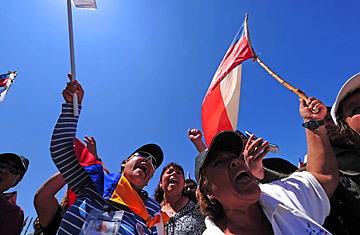
Relatives of the 33 trapped Chilean miners cheer as the custom-built cage built to extract the workers from an underground emergency shelter arrives at the San José mine
Late last week, the giant drill bit boring its way down to the 33 Chilean miners trapped 2,000 ft. (700 m) below the desert floor was about 300 ft. (90 m) away from them when it hit what seemed like an impossibly complicated layer of rock. "That last 100 meters was by far the most difficult part of the hole," says Brandon Fisher, the CEO of Center Rock Inc., the Pennsylvania company that owns and operates the drill. Having to work at that depth, at an 80-degree angle and on an often uneven path was daunting enough. But suddenly "the curves and gyrations got that much sharper," just as the drill reached a football field's distance from the emergency shelter where the men had taken refuge after the Aug. 5 collapse of their gold and copper mine.
But Fisher, 38, tells TIME he "never had any doubt" his drill would reach the trapped men. A native of western Pennsylvania, where his grandfather was a coal miner, Fisher has been pounding his way through the earth with all manner of heavy equipment since he was 18. (He founded Center Rock in 1998.) Eight years ago, his company helped rescue nine miners trapped for five days after the collapse of Pennsylvania's Quecreek Mine. The current mission, however, "was more challenging," particularly since the volcanic rock at the San José mine in Chile's northern desert was "three times harder than what we drilled through at Quecreek, with a lot more turns and deviations involved."
So to enter the final, intricate 300 ft., Fisher ground down parts of the LP (low profile) drill and reduced its 28-in. (70 cm) diameter by a couple inches — and it worked. At 8:05 on Saturday morning, champagne was uncorked above the mine and church bells began peeling in the nearby city of Copiapó as the drill finally tore through the shelter's ceiling. The moment below was caught by a live video feed on which the miners' shouts of joy, says Fisher, seemed to drown out the roar of the drill. "They were pretty elated," says Fisher. "It was one of the happiest moments of my life, the biggest sense of relief I've ever felt. An unbelievably overwhelming feeling." Officials now hope to start carrying the miners up to the light of day by Wednesday.
Yet the remote drama that has gripped the world for 67 days — trapped miners have rarely, if ever, survived this long this far down — had only finished its second act. Saturday's celebration was tempered by the realization that pulling each miner up, inside a specially built 21-in.-wide (50 cm wide) Phoenix capsule, is a risky challenge in itself. Shortly after the drill broke through, Chilean Mining Minister Laurence Golborne said the miners, who share a 538-sq.-ft. (50 sq m) space and have been receiving food and other materials through far narrower shafts since August, would have to use dynamite to blast more space through the shelter ceiling to accommodate the capsule. A bigger concern, however, was how much of the newly drilled shaft should be encased with steel tubing to keep it from itself collapsing as the men are being pulled up. (That lift process could take more than an hour for each of them.)
On Sunday, officials seemed to think that only the shaft's topmost 100 meters needed to be reinforced. But Golborne told reporters at the mine — now a minitown of miners' relatives, workers and media dubbed Camp Hope — that "all rescues have their risks. You can never say that an accident couldn't happen." His sobering reminder: "We still haven't rescued anybody. This won't be over until the last person below leaves this mine."
Still, Saturday's breakthrough was an enormous confidence builder. The rescue marathon — which has included experts from the U.S.'s NASA space agency advising officials on how to keep the miners physically and mentally healthy — has made many Chileans feel a sense of man-on-the-moon accomplishment. Early on in the ordeal, officials had estimated it would take until perhaps November or December to extract the men, but accelerated efforts — Center Rock and the Chilean government, for example, were able to get the drilling equipment in place weeks sooner than expected — cut the time by almost a month. "The miners, their families, the rescuers, the government and all Chileans," President Sebastián Piñera said Saturday, "have offered a display of unity, strength and hope recognized and admired by the entire world." As an almost political aside to his often polarized nation, Piñera added, "When we Chileans set aside our differences ... we are capable of great things."
Meanwhile, the miners — who have signed a pact down in their hole to profit from their story as a group and not individually — have to decide the order in which they'll be pulled up. Rescue workers will join the miners first to make sure they're all fit for the lift. Then the strongest of the group — those who can best deal with any problems on the way up that officials can then fix for the others — will be extracted, followed by the less fit ones. (One candidate for the first miner seems to be the athletic Edison Pena, who has been running in the mine's tunnels each day while listening on his iPod to Elvis Presley music sent down to him by relatives.)
For many, if not most, of the miners' families, however, the hardest part is over. "We feel an enormous happiness," Darwin Contreras, brother of miner Pedro Contreras, 26, told the Associated Press. "Just a little bit longer now." Relatives like Darwin say they've been carried these past 67 days by their religious faith — one as strong, if not stronger, than Fisher's faith in his drill.
